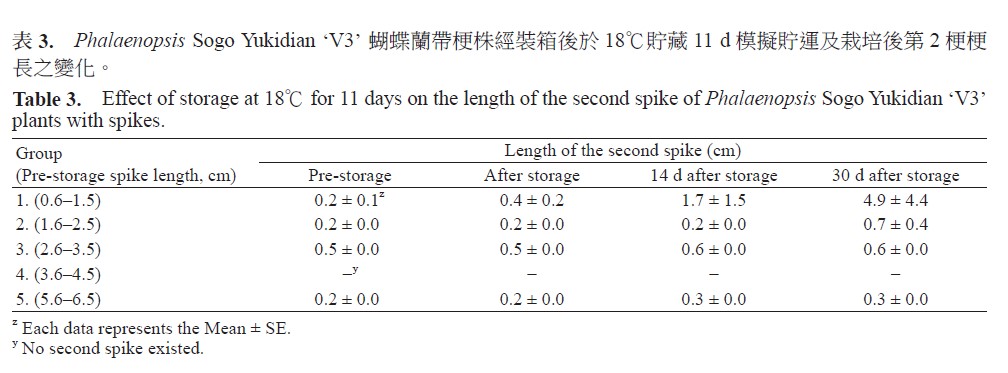All issues

Author:Chao-Chia Huang*, Huei-Suei Huang, and Chin-Yu Tsai
Abstract:
The Phalaenopsis Sogo yukidian ‘V3’ plants with spikes were used in this study. The plants were divided into five groups according to the length of the spike. The average lengths of the spikes in each group were 1.3, 2.2, 3.4, 4.2, and 5.5 cm. All the plants were stored at 18℃ for 11 days as a simulation of marine shipment to Japan. Then they were grown in a greenhouse to observe the changes of spikes and the quality of flowers. The results indicated that the plants with longer spikes (≥ 3.4 cm) usually had only one spike in each plant. About 25% to 44% of plants with shorter spikes (≤ 2.2 cm) had two spikes. After storage all the second spike become aborted. The first spike grew normally. All the plants had one normal spike can bloom eventually. It took about 60 days for the plants with spike to have the first floret bloom after storage. It was about 30 days shorter than those plants without spike. The flower qualities of these plants were very good. At full bloom the stem length was about 50 cm, the inflorescence length was about 42 cm, the number of florets was 12.5 on each spike, and the floret diameter was about 13 cm. The longevity of the spike was about 129 days. All these data indicated that it is feasible to export Phal. Sogo Yukidian ‘V3’ plants with spike to Japan by marine shipment.
Key words:Phalaenopsis, Marine shipment simulation, Spike, Longevity of the spike
Download:![]() PDF Links
PDF Links
- 1. Development of Tractor-Mounted Seedling Transplanter for Sweet Potato
- 2. Synergistic Effect of Additional Gas on the Toxicity of Phosphine to Sitophilus oryzae and Sitophilus zeamais (Coleoptera: Dryophthoridae)
- 3. Effects of Temperature and Solar Radiation on Growth Traits and Plant Elements in Purple Leafy Sweet Potato
 Submit your manuscript
Submit your manuscript
 Guide for authors
Guide for authors